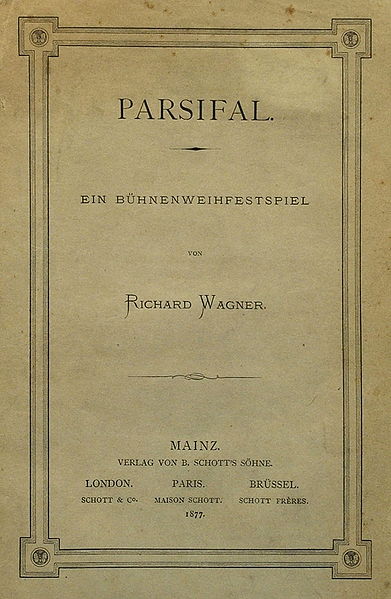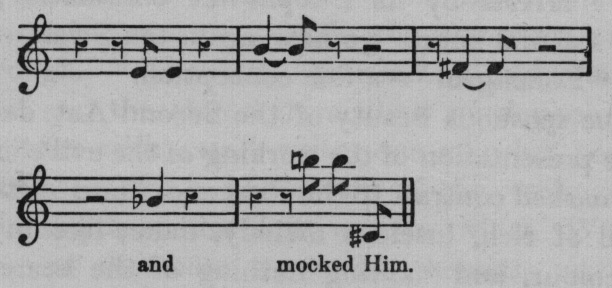Music with Ease > Operas of Richard Wagner > Parsifal (Wagner) - Music
The Music of Parsifal
An Opera by Richard Wagner
One hesitates to write about the music of Parsifal" without having actually heard it. It is rash to judge any composer merely by the written notes, and it is peculiarly rash in the case of Wagner. Taking, however, the score itself and placing it alongside the printed impression of those who have been fortunate enough to hear the work at Bayreuth, one cannot well go far astray in attempting a few brief notes.

Libretto for Wagner's Parsifal (Mainz, 1877)
It is certainly safe to say, at the outset, that in "Parsifal" the music is everything. The libretto has been described as "a farrago of odds and ends, the very dust-bin of Wagner’s philosophies, beliefs, vegetarian, anti-vivisection, and other fads." It does, indeed, smell of the lamp. It lacks spontaneity and dramatic "go." Nothing happens for several hours -- nothing but discourses, philosophical and retrospective. Yet the glorious music carries it all off: floats this inorganic medley on its great waves of sound, making the listener forget entirely the imperfections of the "book."
Music has not known such fervour since the days of Palestrina. A holy and solemn grief pervades it. We seem to be constantly reminded of the great tragedy of Calvary. Wagner wrote once to Liszt: "In all my relations to the suffering world, I feel led and guided by one thing alone -- compassion." And, listening to this fascinating, luxuriant, mellow, soothing music, it would really seem as if compassion had been the one thought in the composer’s mind all through. "The muted pauses, the golden stream of tone, and the almost miraculous musicianship fill the listener with awe," writes one who has been at Bayreuth. Much has been said of the "miraculous musicianship," of the deft way in which Wagner has here, as elsewhere, woven his thematic material. The score is indeed built up in a masterly fashion; but the dramatic influence of the music is so overpowering that all thought of the technical side of the work may be entirely dismissed. The "mood pictures" are the really potent factors.
The First Act, like the last, partakes somewhat of the nature of a grand Communion service, the music being rich and tender, and charged with a noble passion. The short orchestral Prelude, a favourite concert number, attunes the mind to the fundamental thoughts of the drama. Here the principal "motives" which recur throughout are enunciated: among others the Love and the Grail themes, and the Saviour’s Lament theme, which contains some of the most poignant bars Wagner ever wrote. In the last part of the Act a profound impression is made by the clangour of the cathedral bells, at first heard faintly, then working up to a grand peal. The choral music and the "tonal panorama" of boys’ voices are particularly fine, Wagner having here emulated with striking success the service of Rome. The Sorcery motive arrests by its Chopin-like chromatics; and when Parsifal enters we hear again the Swan motive from "Lohengrin" -- a fine conception.
The sensuous beauty of the Second Act, devoted to the presentation of the working of the evil element, is in marked contrast to the First and Third Acts. It is full of rich, luscious melody, dance-like in form and colour, and "asking nothing of the hearer but self-relaxation." The Prelude, again short, is of a passionate, stormy, almost sinister nature, and is based chiefly on the Klingsor and Kundry themes heard in the previous Act. The crowning scene of this Second Act -- perhaps of the whole work -- is the duet between Parsifal and Kundry. Herein "the entire gamut of passion, maternal, exquisite, voluptuous, is traversed by a master hand." So, too, with the wonderful choral scene for sopranos only in the lovely magic garden of Kilngsor’s castle. This is written in as many as eighteen separate groups, and frequently in twelve real parts. Its sweet, plaintive melody and graceful rhythm cannot escape notice; any more than the enchanting waltz and Kundry’s tender recital of the woes and sufferings of Parsifal’s mother, and the glissando passage of the harps (through two octaves) to express the act of hurling the spear at Parsifal’s head. One phrase of Kundry’s description of her sin and punishment has been often cited as the most astonishingly unvocal specimen in all Wagner’s writings:

No wonder an early critic remarked that the singers’ parts are peculiarly trying and thankless!
In the Third Act the gloom deepens to an almost distressing degree. Yet there is some glorious music in it; notably the Good Friday music, also familiar in the concert-room. The Prelude is again short. Its vague rhythm and darkly-tinted intricate harmonies are probably to be taken as illustrating the blind wanderings of Parsifal in search Monsalvat. The last scene is gorgeously led up to-a fitting close to the great life -- work of the last of our really great composers of the nineteenth century.
Music With Ease | About Us | Contact Us | Privacy | Sitemap | Copyright | Terms of Use © 2005-23 musicwithease.com. All Rights Reserved. |
